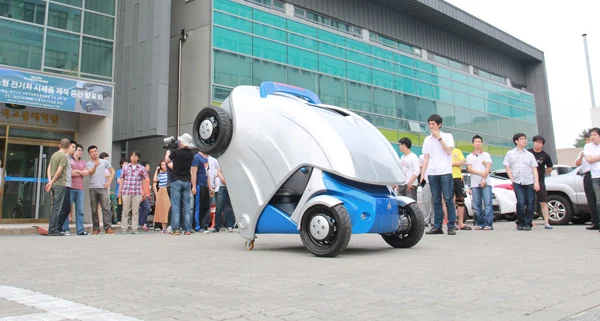The Korea Advanced Institute of Science and Technology (KAIST) has been impressing us with the electric vehicle research it has been doing of late, such as the development and trial of technology that allows electric buses to be charged wirelessly via special plates in the ground as they go about on their routes.
Now the Institute is turning to the notion of how to get more electric cars into urban areas that are compact via a folding design.
KAIST unveiled this week Armadillo-T, an electric car whose design is based on a native animal of South America, the armadillo, a placental mammal with a leathery armor shell. In exact terms of what this means,
the research team imitated the animal’s distinctive protection characteristic of rolling up into a ball when facing with threat from predators. Just as armadillos hide themselves inside the shell, Armadillo-T tucks its rear body away, shrinking its original size of 2.8 meters (110 inches) down to almost half, 1.65 meters (65 inches), when folding.
Once folded up, KAIST said, the electric vehicle “takes up only one-third of a 5-meter parking space, the standard parking size in Korea, allowing three of its kind to be parked.”

image via KAIST
“I expect that people living in cities will eventually shift their preferences from bulky, petro-engine cars to smaller and lighter electric cars,” said In-Soo Suh, associate professor of the Graduate School for Green Transportation at KAIST, in a statement. “Armadillo-T can be one of the alternatives city drivers can opt for. Particularly, this car is ideal for urban travels, including car-sharing and transit transfer, to offer major transportation links in a city. In addition to the urban application, local near-distance travels such as tourist zones or large buildings can be another example of application.”
Armadillo-T is described as a four-wheel drive model with two seats and four in-wheel motors. These motors are installed inside the wheels, while the 13.6 kWh capacity of lithium-ion battery pack is housed on the front side. It is through this configuration that the battery and motors do not have to change their positions when the car folds.
Other features on-board this electric car include cameras installed inside that eliminate the need for side mirrors and smartphone controls which allow for controlling the vehicle and enabling its folding ability. Technical specifications give Armadillo-T a maximum speed of 60 km/h, and with a ten-minute fast charge, the ability to hit up to 100 km.
The concept of Armadillo-T, it is said, was originally initiated in 2011. It has been supported by the Korean government, the Ministry of Land, Infrastructure and Transport and the Korea Agency for Infrastructure Technology Advancement, since December of last year. There’s no word on if we might one day see an actual production model of this being produced somewhere in the world.






